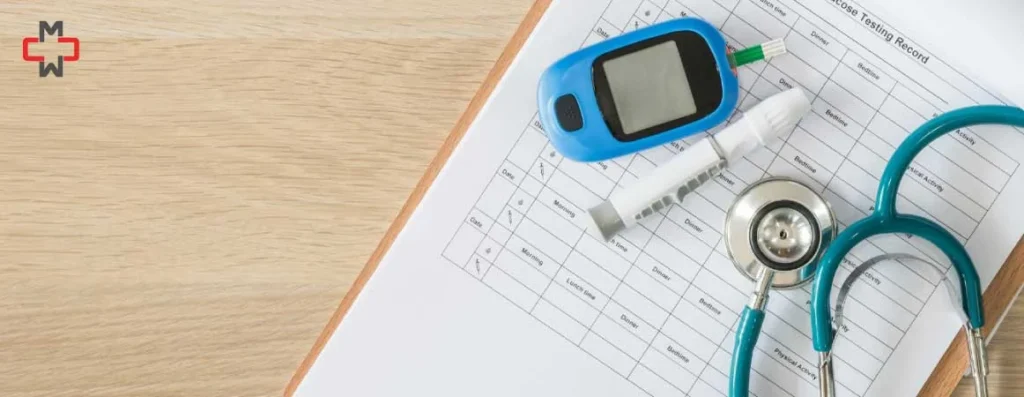Diabetes is a disease in which the function of processing the glucose level in the blood gets altered. This blood glucose is also termed blood sugar. According to one report, the United States has over 30.2 million people over the age of 18 who have either diagnosed or undiagnosed diabetes. If left untreated or unmanaged, diabetes can become fatal and lethal as well. The high level of blood glucose can lead to dangerous issues like heart disease (angina) and stroke. Managing diabetes depends on the type of diabetes that a person suffers from. It is important to know that being overweight is not the only factor contributing to diabetes. For patients suffering from diabetes, a primary care physician is extremely important.
Types of Diabetes:
Diabetes can be divided basically into three basic types:
1. Type 1 Diabetes:
Diabetes type 1 is also known as juvenile diabetes. In this disease, the body is unable to produce insulin thus the body becomes insulin-dependent. People with type 1 diabetes need to take insulin artificially to maintain good health.
2. Diabetes Type 2:
In this type of diabetes, there is an issue with the proper utilization of insulin by the body. In this type of diabetes, the body makes insulin, unlike in type 1 diabetes, where the body cannot make insulin. According to a report by the National Institute of Diabetes and Digestive and Kidney Disease, type two is the most commonly occurring diabetes in the general population. It is a fact that type two diabetes has strong links with obesity.
3. Gestational Diabetes:
Gestational diabetes is not a lifelong disease. A person suffers from gestational diabetes during the period of pregnancy. It commonly occurs after giving birth to a newborn.
What is Prediabetes:
Prediabetes is a term used by professionals to refer to a condition when the blood glucose level is in the range of 100 to 125 (mg/dl). It is unusual because the normal range of blood sugar is 70 to 99 (mg/dl. However, a person suffering from diabetes has a blood sugar level greater than 126 (mg/dl). Thus, we can conclude that prediabetes is a condition where the blood glucose level is higher than the normal level but it is not as high as to be called diabetes. It is considered that people with prediabetes are at higher risk of developing diabetes type 2, but they usually do not show symptoms of diabetes.
What are the Risk Factors for Diabetes:
The following are considered risk factors for diabetes in the general population:
- Obesity
- Diabetes running in family
- High levels of high-density lipoprotein (HDL) are generally less than 40 mg/dl or 50mg/dl
- Rising blood pressure
- Gestational diabetes
- Polycystic ovary syndrome (PCOS)
- Age greater than 45 years
- Inactive lifestyle
If a doctor suggests and finds out that a person has prediabetes, a patient needs to be careful in the intake of food and also should change their lifestyle. Healthy activities, exercise, and a healthy and balanced diet should be adopted immediately.
Role of Exercise and Diet:
Exercise and diet both play a paramount role in dealing with diabetes mellitus. A person with type 2 diabetes must incorporate healthy changes in lifestyle and diet to control diabetes. Prescribers usually refer such patients to nutritionists as well. A nutritionist suggests lifestyle changes to deal effectively with the disease. For instance
Diet should contain an increased quantity of fruits, vegetables, whole grains, and healthy fat sources.
A diet should contain a minimum quantity of high-sugar foods, and junk food should be avoided completely.
Diet should contain minimum or no alcohol.
The patient should exercise daily for 30 minutes at least, and should also get involved in healthy activities like swimming, walking, aerobics, etc
However, the patient should be aware of low blood sugar levels during rigorous activities and exercise and how to deal with such a situation. For me, the role of the primary care doctor becomes extremely important in such a situation. The patient should be aware of taking glucose or sugar to replenish falling blood glucose levels immediately.
The patient should take measures to control their body mass index (BMI) in the normal range.
How to Use Insulin?
Patients with type 1 diabetes are fully dependent on insulin. However, patients with type 2 diabetes also need to inject insulin at times, with or without the use of oral hypoglycemic agents.
Types of Insulin:
Various types of insulin are present depending on their mechanism and duration of action. These types vary from rapid, regular, long-acting, and intermediate-acting insulin. Sometimes doctors prescribe the use of long-acting insulin to control blood sugar levels in the low range.
Role of Self-monitoring:
People injecting insulin regularly are prescribed to keep up with the special portable machine for checking their blood glucose levels at regular intervals. It is important to monitor blood glucose levels as insulin is injected directly into the skin, so the patient should monitor blood glucose levels cautiously as well. Insulin undoubtedly helps a person to live, but it has some serious side effects as well. Over-injection of insulin can lead to sudden hypoglycemia, nausea, and sweating. Patients in such cases need immediate help from a family care doctor. Thus people taking insulin need excessive care in their diet as well as insulin administration both.
Oral Hypoglycemics:
Oral hypoglycemics are substances used for decreasing blood glucose levels. Taking tablets orally helps to control diabetes as well. Drugs include:
Metformin
It lowers the blood sugar level and also improves the effect of insulin
SGLT2 Inhibitors
These are inhibitors of sodium-glucose co-transporter (SGLT2) and help in controlling blood glucose levels in the body.
Points to Ponder:
Diabetes is a condition that requires a thorough change of lifestyle and demands careful sugar management. Moreover, diabetes is a disease that is managed successfully by many people across the globe with the help of the teamwork of practitioners, pharmacists, nurses, and nutritionists. The diabetes rate is no doubt increasing rapidly in many parts of the United States, like New York, and Manhattan. It is thus necessary to fight diabetes on individual and collective levels to make society healthy and free of diseases like diabetes.
– Disclaimer –
This blog is for informational & educational purposes only, and does not intend to substitute any professional medical advice or consultation. For any health related concerns, please consult with your physician, or call 911.
-
About The Author
Dr. Syra Hanif M.D.Board Certified Primary Care Physician
Dr. Syra Hanif is a board-certified Primary Care Physician (PCP) dedicated to providing compassionate, patient-centered healthcare.
Read More







